The AMD Kabini Review: A4-5000 APU Tested
by Jarred Walton on May 23, 2013 12:00 AM ESTKabini Gaming and Battery Life
We've covered the general performance and some synthetic graphics tests. What about actual games? Well, here’s what our (admittedly punishing) 2013 gaming suite looks like on Kabini. These are the "Value" results, as the "Mainstream" and "Enthusiast" settings are unplayable on anything without a dGPU (though those results are available in Mobile Bench if you're interested).
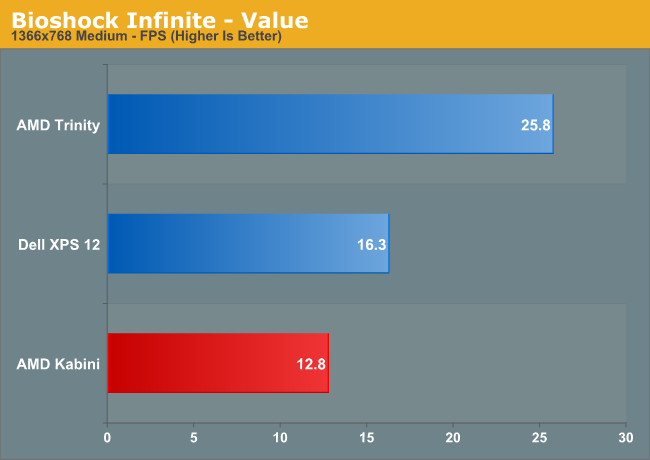

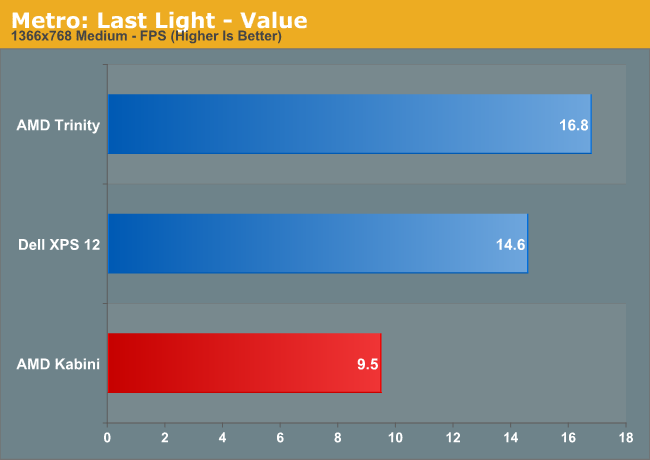
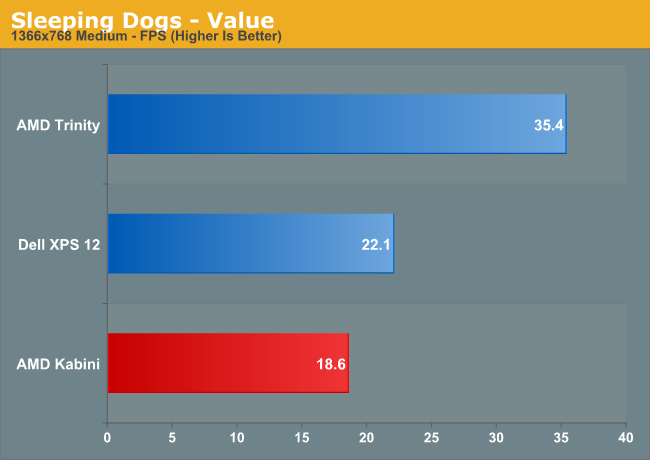
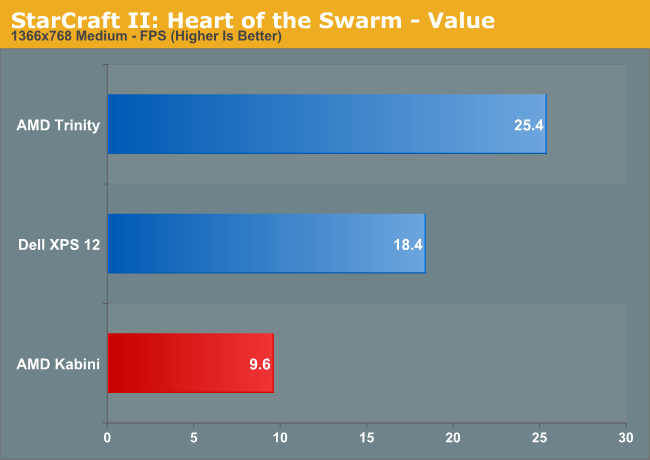
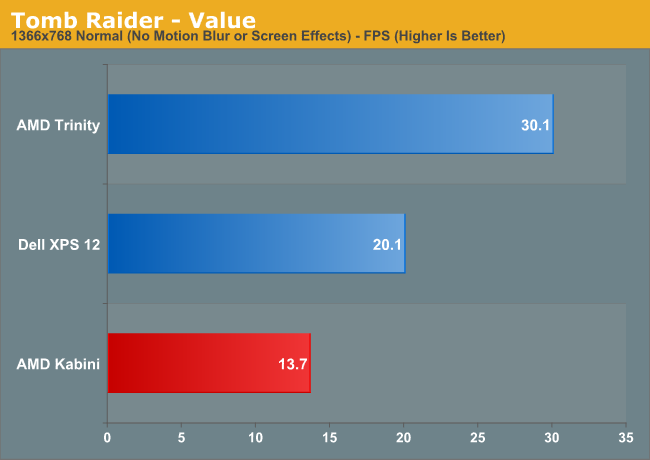
The short summary is that not a single game manages to crest the 30FPS mark, and I even ran additional tests at the minimum quality settings (at 1366x768) to see if I could improve the results. Sadly, I couldn’t, at least not enough to make the games playable; the best I managed was around 25 FPS in Bioshock, Skyrim, and Tomb Raider at minimum detail, and most titles remained in the sub-20 FPS range. Titles that tend to be more taxing on the CPU side of things like StarCraft II are even worse, with frame rates in StarCraft II being half of what IVB ULV gets at our Value (medium quality minus antialiasing) preset.
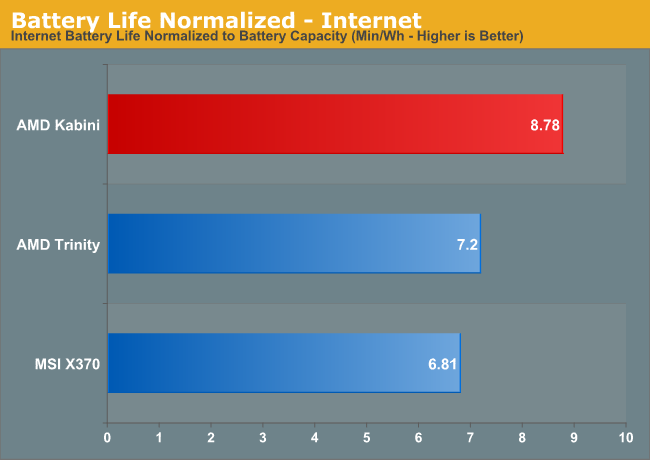
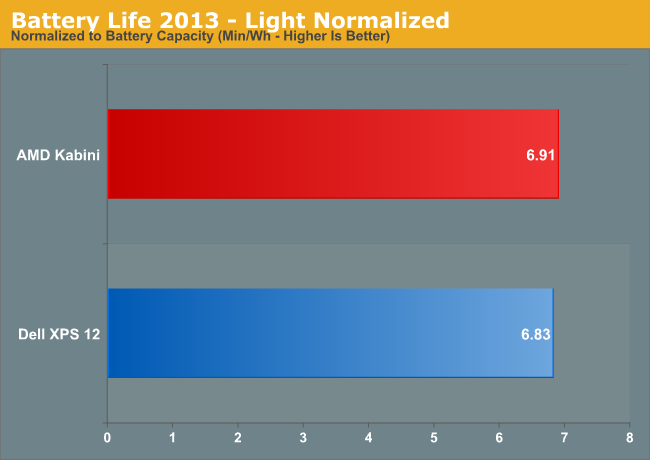
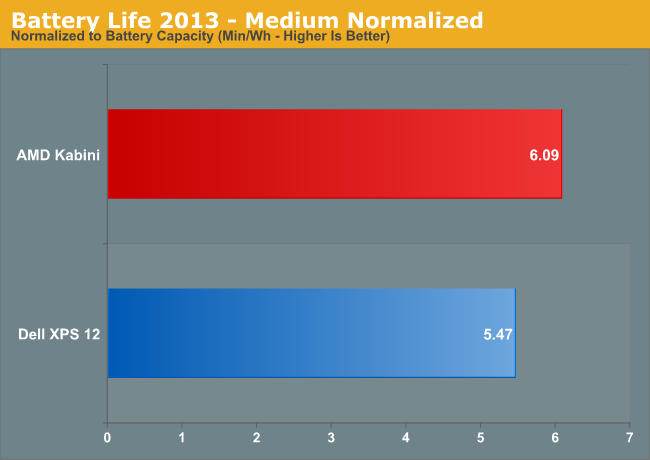
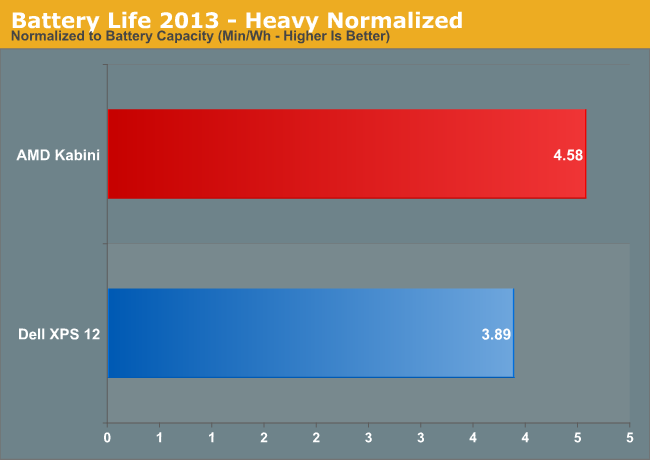
The good news is that not only is Kabini noticeably faster than Brazos, but it’s also mighty frugal when it comes to power use. We don’t have any Brazos laptops handy, so we had to use our older Internet battery life test as a comparison point (100 nits instead of 200 nits); in that test, Kabini topped 6.5 hours with a 45Wh battery. The MSI X370 we’re using as a comparison point did last a bit longer, but it also has a 64Wh battery. In terms of normalized power use, the Kabini laptop ends up being 29% more efficient, and that’s with a 14” AHVA 1080p panel going up against a 13.3” TN 768p display. We’re not quite able to compare apples to apples, but Kabini definitely looks like a good improvement over Brazos in power use.
The power story is even better when we look at ULV Ivy Bridge and standard Trinity APUs. Using our new battery life tests, which push the hardware a lot harder than our previous tests, Kabini delivers normalized battery life that’s at least equal to IVB ULV (our “Light” test), and in the more taxing Medium and Heavy tests Kabini beats ULV by 11% and 18%, respectively. Of course the IVB ULV system is still faster, and it’s also likely to cost twice what we expect Kabini laptops to sell for, but lower cost Celeron and Pentium ULV parts shouldn't be all that different. Also of note is that we don’t know yet how Haswell will fare in these same tests, but that’s an area Intel seems to be focusing on for their next CPU; that’s a story for next month….










130 Comments
View All Comments
Gaugamela - Friday, May 24, 2013 - link
I'll beg to disagree with that. As a non-promotional price, for a notebook with a 1080p touchscreen display I think that 500$ is more than fair. As for promotions happening your line of reasoning seems to assume that discounts will only affect Intel notebooks which isn't clearly the case.While you may get cheap Ivy Bridge notebooks when in promotion, go search for cheap Trinity/brazos notebooks with promotions and you'll find them even cheaper. The same will be said of Temash/Kabini notebooks.
I fail to understand why you don't seem to acknowledge that.
Or the proposition of an APU that beats Pentiums and Celerons in performance (excluding single-thread performance, which is much less relevant nowadays) and has superior battery life.
Will Atom and Haswell Pentiums offer better performance/efficiency/price ratio? It remains to be seen.
whyso - Friday, May 24, 2013 - link
Depends really. With a 1080p screen its a good price. Sales happen all the time. Yes you can and will get i3 ULV systems for cheap and can get kabini systems for cheap. I'm simply saying given the fact that these promotion happen all the time literally (go to newegg laptops, sort by price-lowest and more than 75% of the notebooks on that page are on sale) you have to take these things into consideration. Kabini is competing against discounted but perfectly fine notebooks in this segment. You can get a nice lenovo g580 with SV i3 for $350. Any promotion that runs with a kabini notebook will have to match that price/perf and kabini is much weaker than SV i3.http://www.newegg.com/Product/Product.aspx?Item=N8...
whyso - Friday, May 24, 2013 - link
Sale % was taken from .ca g580 price from .com for .ca about half are on sale.dusk007 - Thursday, May 23, 2013 - link
The performance quite poor and notebookcheck doesn't really tell a different story. An i5 is the right CPU to compare it too because it runs in the same performance envelope. With all the other stuff that goes into a decent notebook or tablet/hybrid the CPU cost alone does make that much of a difference.The problem with Kabini is Single Threaded performance which matters for responsivness in plain old office work loads. Which is what most of these notebooks do. x264, cinebench, ... none of that really matters.
And gaming. In game low settings don't do much for CPU requirements and that is why even at low many games aren't playable. Something Intel can offer despite its HD 4000 which has nowhere near the reputation of AMD's GCN. If all you want is an office notebook for some casual gaming like a bit of Starcraft. An i5 is still a worthwhile investment.
Gaugamela - Thursday, May 23, 2013 - link
The i5 is the right CPU because it runs in the same performance envelope??????? How about no??How much more does the i5 cost?
andrewaggb - Thursday, May 23, 2013 - link
Well theres two arguements. One is cost, and yes amd will come in cheaper because intel likes their margins. So if cost is your primary motivator than this chip looks good.The other argument is performance/watt and peak performance, both of which make an i5 look much better than this chip.
Now it's true an i5 doesn't scale down to 3.9W, so in that market this chip appears to be a real contender and the one to beat. But that's not the version that was tested here today so we don't know that for sure.
Personally, I'm disappointed, and think haswell will compare very favorably in all metrics except price. I'm not sure haswell will be tablet suitable though, where some sku's of this chip should be.
Not saying this chip is terrible, just saying for anything 8-9W and up it seems to me haswell will be the clear choice if price isn't a major factor.
Gaugamela - Friday, May 24, 2013 - link
And this is a product that competes on price and battery life. Not performance as Haswell does.dusk007 - Saturday, May 25, 2013 - link
Just that it does compete on performance doesn't mean performance isn't valuable information. How much speed loss are you dealing with when going with cost effectiveness. This isn't a smartphone CPU that will ultimately end up running different software. It is still Windows and the same games and programs as an i5 is used for.The cost difference in the end product isn't that huge or insurmountable. The buyer would like to know how much they get when paying up or who much they loose when going cheap. Comparing it only with Atoms would be cheating and something marketing folks do not a review site that wants to have some reputation.
These chips don't go into Smartphones not even Tablets (that is Temash) they go where 15W Haswells will go and 2/3 of those sub $800 notebooks BOM is still none CPU related. So even if Kabini was given away for free the notebooks would still cost something.
Parhel - Friday, May 24, 2013 - link
But price is always a major factor. It's the "majorest" factor. This is a site for enthusiasts (read geeks) but think of the person at the AT&T store who picks the 2 or 3 generation old iPhone because it's $50 cheaper.tunaman - Thursday, May 23, 2013 - link
AMD set the standard with x64 that Intel evetually agreed was superior and joined. With the introduction of these hUMA (fully shared CPU and GPU memory) chips AMD has again set the standard that Intel will have to copy.As I've said before; Intel hasn't been a tech leader in a decade and, again, they'll be playing catch up once they cave to AMD's superior design. But by then, just as has been true for years, Intel graphics and multitasking will continue to lag behind AMD. Intel's only bragging right is saving one or two watts and slapping an "Intel Inside" tatoo on products, but charging twice as much for it. http://goo.gl/OItwV